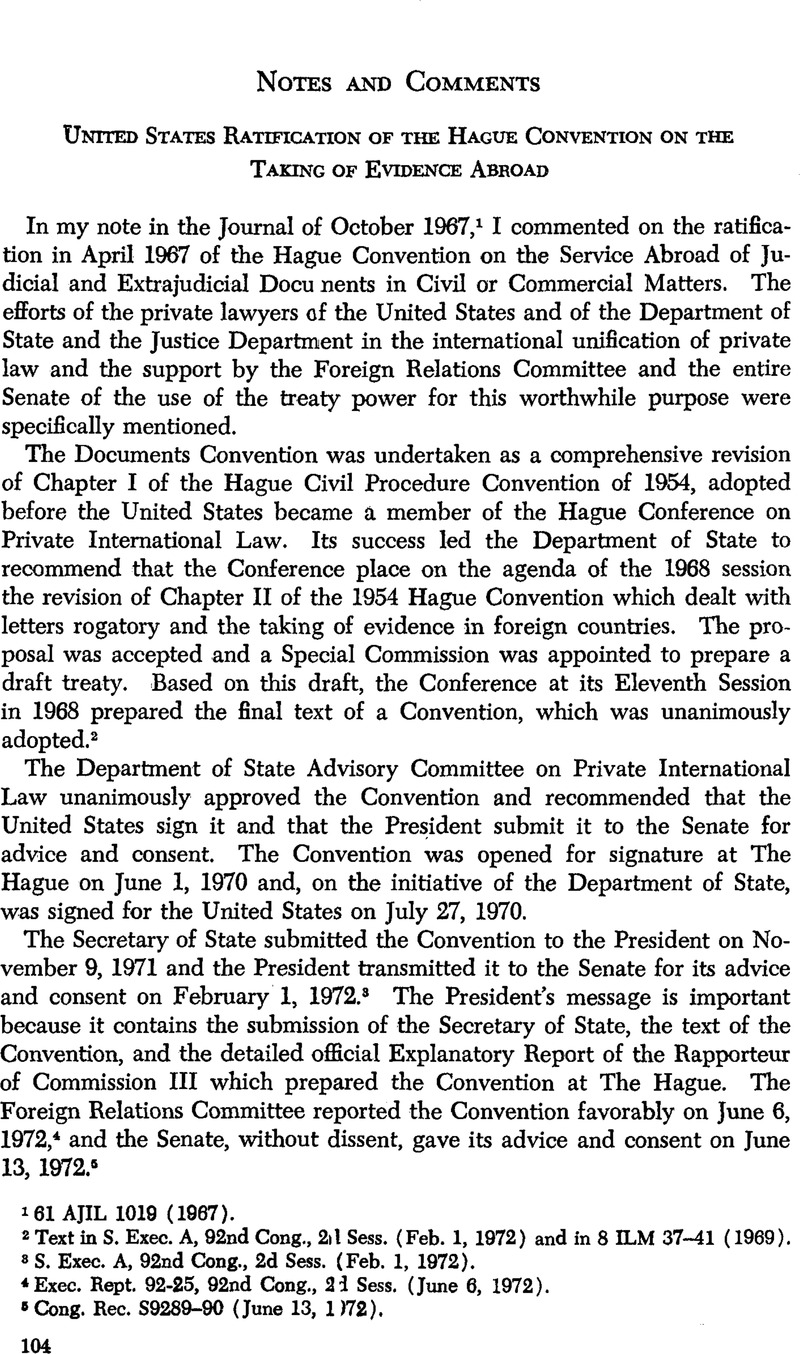No CrossRef data available.
Article contents
United States Ratification of the Hague Convention on the Taking of Evidence Abroad
Published online by Cambridge University Press: 28 March 2017
Abstract

- Type
- Notes and Comments
- Information
- Copyright
- Copyright © American Society of International Law 1973
References
1 61 AJIL 1019 (1967).
2 Text in S. Exec. A, 92nd Cong., 2 II Sess. (Feb. 1, 1972) and in 8 ELM 37–41 (1969).
3 S. Exec. A, 92nd Cong., 2d Sess. (Feb. 1, 1972).
4 Exec. Rept. 92–25, 92nd Cong., 2 i Sess. (June 6, 1972).
5 Cong. Rec. S9289–90 (June 13, 1)72).
6 “Report of the United States Delegation to Eleventh Session of the Hague Conference on Private International Law,” 8 ILM 804–820; Amram, , The Proposed Convention on the Taking of Evidence Abroad , 55 A.B.A.J. 651 (1969)Google Scholar. The Convention received the unanimous approval of the House of Delegates of the American Bar Association at the meeting in Dallas in 1969.
7 See Amram, , United States Ratification of the Hague Convention on Service of Documents Abroad , 61 AJIL 1019 (1967)Google Scholar.
8 A review of this history since 1938 will be found in Amram, , The Proposed International Convention on the Service of Documents Abroad , 52 A.B.A.J. 650 (1965)Google Scholar.
9 Public Law 88–619; 78 Stat. 995, amending 18 U.S. Code ?§ 1621, 3491, 28 U.S. Code $§ 1696, 1741, 1742, 1745, 1781, 1782, 1783, 1784, 1785. The Legislative History will be found at U.S. Code Congressional and Administrative News, 88th Cong., 2d Sess., 1964, at page 3782.
10 Amendments adding Rule 4(i), amending Rule 28(b), amending Rule 44, and adding Rule 44.1 to the Rules of Civil Procedure and adding Rule 26.1 to the Rules of Criminal Procedure, all effective July 1, 1966.
11 The Convention entered into force on Feb. 10, 1969. Fourteen countries are now parties to the Convention. See 20 U.S.T. 361.
12 Art. 38 provides that the Convention will come into force 60 days after the deposit of the third instrument of ratification.
13 The Report of the Rapporteur of the Convention notes that the word “incompatible” does not mean “different” from the domestic law; it means that a constitutional or statutory barrier in the domestic law prevents compliance with the request to apply a foreign procedure.
14 This word was used to maximize international cooperation and to minimize the possibilities of refusal to cooperate.
15 See Art. 2 of the Documents Convention.
16 The Department of State is presently the Central Authority under the Documents Convention, with the cooperation of the Department of Justice.
17 “In executing a Letter of Request the requested authority shall apply the appropriate measure of compulsion. . . .” (emphasis added).
18 Art. 19 of the Documents Convention.
19 Art. 33 provides, in para. 1, “A State may, at the time of signature, ratification or accession exclude, in whole or in part, the application of the provisions of Paragraph 2 of Article 4 and of Chapter II. No other reservation shall be permitted.” Art. 4(2) deals with the English-French language provisions discussed above; Chapter II deals with the taking of evidence by diplomatic officers, consular agents, and commissioners.
20 See Art. 3, para. 2.




